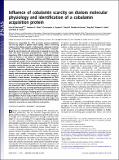Influence of cobalamin scarcity on diatom molecular physiology and identification of a cobalamin acquisition protein
Author(s)
Bertrand, Erin Marie; Allen, Andrew E.; Dupont, Christopher L.; Norden-Krichmar, Trina M.; Bai, Jing; Valas, Ruben E.; Saito, Mak A.; ... Show more Show less
DownloadBertrand-2012-Influence of cobalam.pdf (1.597Mb)
PUBLISHER_POLICY
Publisher Policy
Article is made available in accordance with the publisher's policy and may be subject to US copyright law. Please refer to the publisher's site for terms of use.
Metadata
Show full item recordAbstract
Diatoms are responsible for ∼40% of marine primary production and are key players in global carbon cycling. There is mounting evidence that diatom growth is influenced by cobalamin (vitamin B12) availability. This cobalt-containing micronutrient is only produced by some bacteria and archaea but is required by many diatoms and other eukaryotic phytoplankton. Despite its potential importance, little is known about mechanisms of cobalamin acquisition in diatoms or the impact of cobalamin scarcity on diatom molecular physiology. Proteomic profiling and RNA-sequencing transcriptomic analysis of the cultured diatoms Phaeodactylum tricornutum and Thalassiosira pseudonana revealed three distinct strategies used by diatoms to cope with low cobalamin: increased cobalamin acquisition machinery, decreased cobalamin demand, and management of reduced methionine synthase activity through changes in folate and S-adenosyl methionine metabolism. One previously uncharacterized protein, cobalamin acquisition protein 1 (CBA1), was up to 160-fold more abundant under low cobalamin availability in both diatoms. Autologous overexpression of CBA1 revealed association with the outside of the cell and likely endoplasmic reticulum localization. Cobalamin uptake rates were elevated in strains overexpressing CBA1, directly linking this protein to cobalamin acquisition. CBA1 is unlike characterized cobalamin acquisition proteins and is the only currently identified algal protein known to be implicated in cobalamin uptake. The abundance and widespread distribution of transcripts encoding CBA1 in environmental samples suggests that cobalamin is an important nutritional factor for phytoplankton. Future study of CBA1 and other molecular signatures of cobalamin scarcity identified here will yield insight into the evolution of cobalamin utilization and facilitate monitoring of cobalamin starvation in oceanic diatom communities.
Date issued
2012-05Department
Woods Hole Oceanographic InstitutionJournal
Proceedings of the National Academy of Sciences
Publisher
National Academy of Sciences
Citation
Bertrand, E. M. et al. “Influence of Cobalamin Scarcity on Diatom Molecular Physiology and Identification of a Cobalamin Acquisition Protein.” Proceedings of the National Academy of Sciences 109.26 (2012): E1762–E1771. ©2012 by the National Academy of Sciences
Version: Final published version
ISSN
0027-8424
1091-6490